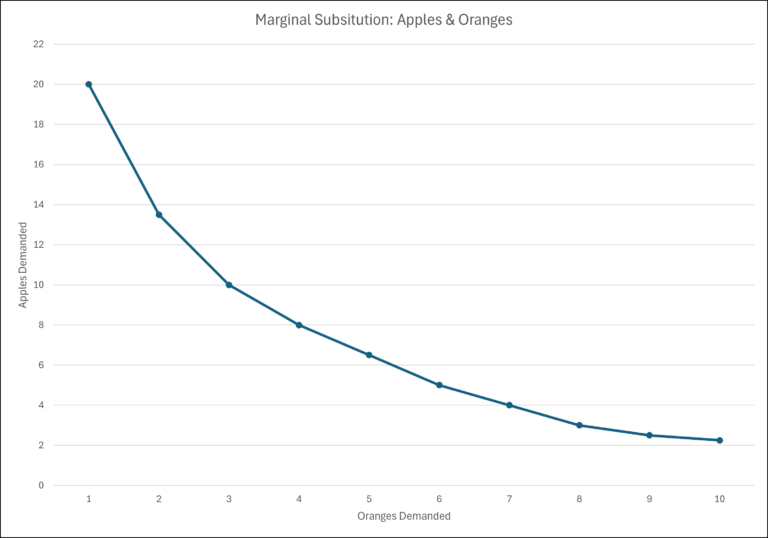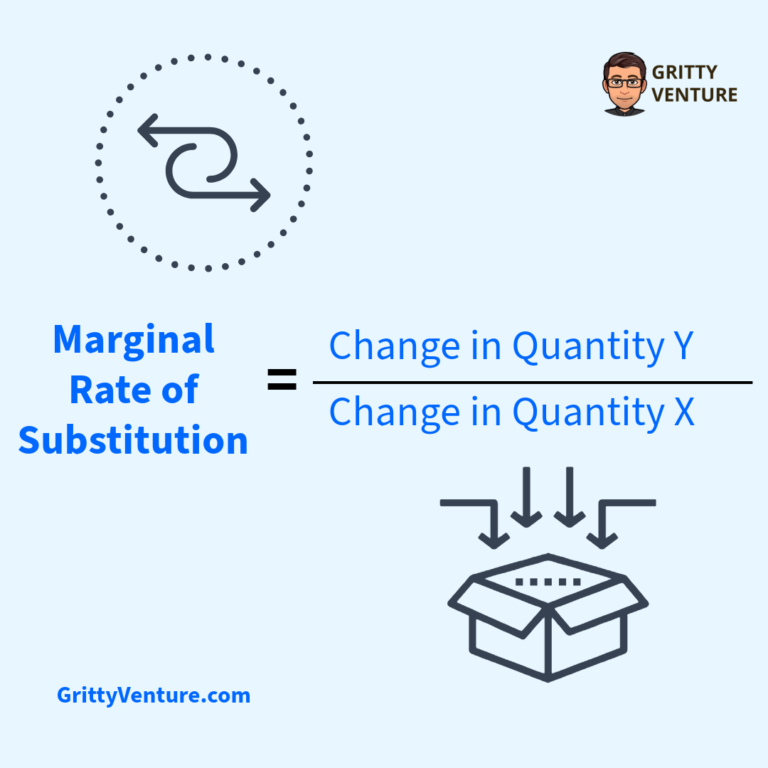Ever wondered why you’d happily trade a couple of apples for an orange, but then hesitate when it comes to trading more apples for another orange?
This seemingly simple decision-making process is at the heart of a fundamental economic concept: the Marginal Rate of Substitution (MRS). Understanding MRS can give you valuable insights into how we make choices and prioritize different goods and services.
So, what exactly is the MRS?
In simple terms, it’s the rate at which a consumer is willing to give up one good to obtain an additional unit of another good while maintaining the same level of satisfaction (or utility). Think of it as the “exchange rate” of happiness between two goods.
Let’s explain it with an example. Imagine you have a basket of apples and oranges. Your MRS of oranges for apples tells us how many apples you’re willing to sacrifice to get one more orange. If your MRS is 3, you’d be willing to sacrifice 3 apples to get 1 additional orange.
Marginal Rate of Substitution and Indifference Curves
The concept of MRS is best understood in the context of indifference curves – graphs that represent combinations of two goods that provide the same level of satisfaction to a consumer. The MRS at any point on the curve shows how much of one good a consumer is willing to trade for another without affecting their overall happiness.
A key characteristic of MRS is that it typically diminishes as one moves down an indifference curve. This phenomenon is known as the diminishing marginal rate of substitution, which suggests that as people consume more of one good, they are willing to give up less of the other good to obtain additional units.

Take the chart above as an example. It shows a theoretical MRS curve for someone who likes apples and oranges. This person starts with 20 apples and 1 orange. The chart shows that they would be quite satisfied with another orange and would be willing to give up ~6 apples to gain that additional orange. However, as they continue along the curve, their preference for additional oranges decreases. This change illustrates the concept of diminishing MRS.
As the consumer trades along the curve, they are keeping their utility, or total satisfaction, constant while working towards the optimal solution for them.
Mathematical Representation of MRS
Mathematically, the MRS is calculated as:

Where X and Y are two goods to be compared. The negative sign above indicates that as the quantity of one good increases, the quantity of the other good decreases to maintain constant utility (as described above with apples and oranges). The MRS is critical to determining consumer demand patterns as it reflects consumer tastes and preferences.
MRS is based on the law of diminishing marginal utility, which states that as a person consumes more of a good, the additional satisfaction (marginal utility) derived from each additional unit decreases. As a result, consumers become less willing to trade one good for another at the same rate over time.
Marginal Rate of Substitution Calculator
Below is a marginal rate of substitution calculator that I have put together and is free to use. Simply include your email and it will take you to the calculation page.
Once on the calculation page, you can use the calculator without needing to actually submit your email (having a 2nd page helps control the spam).
If you do submit your email you will be taken to a private page on my website where you can access and download Excel files of all the calculators available today and access a link to the Private Facebook Group to continue the discussion (again, without spam!).
Key takeaways about the MRS:
- Diminishing Marginal Rate of Substitution: This is a crucial point. As you consume more of one good, your willingness to trade for even more of it decreases. Going back to our apple and orange example, if you already have a lot of oranges, you’re less likely to give up many apples for just one more orange. Your MRS will be lower. This reflects the common-sense idea that the more we have of something, the less we value an additional unit of it.
- MRS and Indifference Curves: The MRS is directly related to indifference curves. An indifference curve represents all the combinations of two goods that give a consumer the same level of satisfaction. The MRS at any point on an indifference curve is equal to the absolute value of the slope of the tangent line at that point. Steeper slopes indicate a higher MRS, meaning the consumer is willing to give up a lot of one good for the other. Flatter slopes mean the opposite.
- MRS and Optimal Choice: Consumers aim to maximize their utility, given their budget constraints. The optimal consumption point occurs where the MRS is equal to the price ratio of the two goods. This makes intuitive sense: if the rate at which you’re willing to trade two goods (MRS) is equal to the rate at which you can trade them in the market (price ratio), you’ve reached the most satisfying balance.
Why Is Understanding MRS Important?
- Understanding Consumer Behavior: MRS helps us predict how consumers will react to changes in prices or availability of goods.
- Business Decisions: Businesses can use the concept of MRS to understand consumer preferences and set prices accordingly.
- Resource Allocation: MRS plays a role in understanding how resources are allocated in a market economy.
Why Does MRS Matter in Economics?
The concept of MRS plays a crucial role in various economic theories, including:
- Consumer Decision-Making: MRS helps determine optimal consumption choices given a consumer’s budget constraint.
- Demand Theory: MRS influences how changes in relative prices affect demand for goods.
- Production Theory: The Marginal Rate of Technical Substitution (MRTS) is a similar concept applied to production, showing how firms substitute labor for capital.
- Pricing Strategies: Businesses use MRS insights to set prices that align with consumer preferences.
Limitations of MRS
Despite its usefulness, MRS has some limitations:
- Assumes Rational Behavior: Consumers may not always act rationally or consistently in their substitution decisions.
- Ignores Psychological Factors: Preferences can be influenced by advertising, branding, and social trends.
- Does Not Apply to All Goods: Some goods (e.g., essential medicines) have little or no substitutability.
- Constant or Undefined MRS: In cases of perfect substitutes or perfect complements, MRS becomes either constant or undefined, making traditional analysis difficult.
Bringing It Home
The Marginal Rate of Substitution (MRS) is a crucial concept in economics that explains how consumers trade off one good for another while maintaining the same utility. It provides insight into consumer preferences, demand patterns, and pricing strategies. MRS is closely related to indifference curves and plays a fundamental role in microeconomic theory. However, its real-world application is limited by assumptions of rationality and the complexities of human behavior. Understanding MRS is essential for economists, businesses, and policymakers looking to analyze consumer choices and market trends.
Would you be willing to give up your morning coffee for an extra hour of sleep? Your personal MRS might have the answer!



